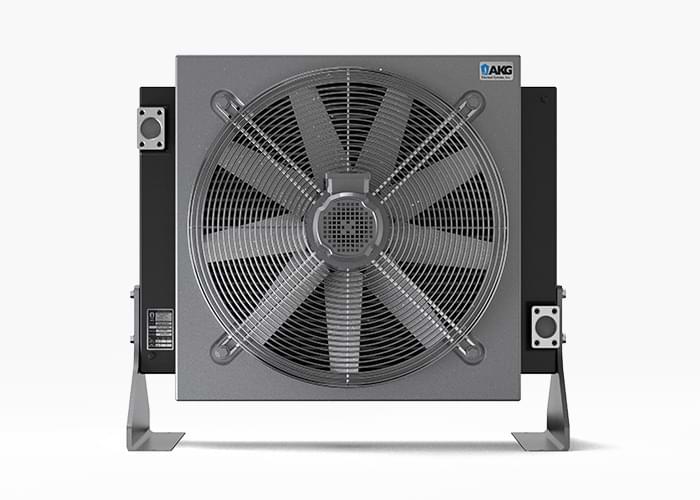Air-Cooled Aftercoolers
Air-cooled aftercoolers are critical components in compressor systems, designed to cool hot compressed air, condense moisture, and deliver clean, dry air to downstream equipment. These units utilize ambient air, driven by fans, to dissipate heat through a high-efficiency heat exchanger, typically constructed with aluminum or copper fins for optimal thermal performance. By reducing air temperature to within 15-20°F of ambient conditions, they prevent corrosion, protect tools, and ensure consistent process quality in industries such as manufacturing, automotive, and construction.
The robust design of air-cooled aftercoolers allows them to operate effectively in diverse environments, from dusty job sites to controlled industrial settings. They are available in various configurations, including AC-powered, DC-powered, pneumatic-driven, and core-only models, to suit stationary or mobile compressor setups. Features like low-pressure drop and easy-to-clean fins enhance efficiency and maintenance, while customizable fittings ensure compatibility with different compressor types. These aftercoolers are engineered for durability, energy efficiency, and seamless integration, making them a reliable choice for optimizing compressed air systems.
Applications include cooling air for pneumatic tools, spray painting, sandblasting, and food processing, where moisture control is essential. By removing up to 75% of water vapor when paired with a moisture separator, air-cooled aftercoolers safeguard equipment, reduce maintenance costs, and improve operational reliability across a wide range of compressor-driven processes.

Configuration
Capacity:
5 SCFM to 7500 SCFM
Pressure:
30 to 300 PSI
Motor Types:
AC / DC / AIR
Standard Features
- High-Efficiency Aluminum Fins
- Powder-Coated Steel Housing
- Low-Pressure Drop Design
- Corrosion-Resistant Construction
- Compatible with SAE/NPT Fittings
- Optimized for Easy Maintenance
- High-Strength Fan Blades
- ASME-Compliant Pressure Testing
- Thermal Performance Validation
- Anti-Vibration Mounting Options
Air-Cooled Aftercoolers for Compressors
In compressor systems across manufacturing, construction, and automotive industries, air-cooled aftercoolers are vital for maintaining air quality and system efficiency. By cooling compressed air and removing moisture, these units prevent corrosion, extend equipment life, and ensure reliable performance in demanding applications.
Types of Air-Cooled Aftercoolers
Air-cooled aftercoolers come in AC-powered, DC-powered, pneumatic-driven, and core-only configurations, tailored for stationary or mobile compressors. Constructed with high-efficiency aluminum or copper heat exchangers, they offer robust cooling for flow rates ranging from 50 to 5,000 SCFM, meeting diverse industrial needs.
Aftercooler Design
Our air-cooled aftercoolers feature durable aluminum fins and corrosion-resistant steel housings, designed for low-pressure drop and easy maintenance. Available in sizes from 10" to 300" in length, they support ASME and ISO standards. Standard models include NPT or flange connections, with options for custom fittings, anti-vibration mounts, and passivation for enhanced durability. Flow capacities range from 50 to 5,000 SCFM, with pressure ratings up to 300 PSI and temperatures up to 400°F. Upgrades include high-performance fans, multi-pass designs, and compliance with stringent industry standards for critical applications.

Design Requirements for Air-Cooled Aftercoolers
Key design considerations include high thermal efficiency, low-pressure drop, and compatibility with compressor systems. Features like polished fin surfaces, robust fan guards, and compliance with ASME standards ensure performance and safety. Customizable options accommodate specific flow rates, environmental conditions, and installation constraints.
Applications of Air-Cooled Aftercoolers
These aftercoolers are integral to compressor systems in manufacturing, automotive, construction, and food processing. They cool air for pneumatic tools, spray painting, sandblasting, and packaging, reducing moisture to prevent corrosion and ensure product quality. Applications include air compression for HVAC systems, industrial automation, and heavy machinery operation.
Benefits of Air-Cooled Aftercoolers
Air-cooled aftercoolers are energy-efficient, requiring no water supply, and offer low maintenance due to their simple, fan-driven design. They provide consistent cooling, high durability, and flexibility for stationary or mobile setups. Cost-effective operation, easy installation, and customizable configurations make them ideal for diverse compressor applications.
Industry Standards
Our aftercoolers meet ASME and ISO standards, ensuring reliability and compliance. Rigorous testing, including hydrostatic pressure and thermal performance validation, guarantees consistent operation under demanding conditions.
Maintenance and Upgrades
Regular maintenance involves cleaning fins and checking fan operation to maintain airflow. Upgrades include corrosion-resistant coatings, enhanced fan motors, custom mounting solutions, and compliance with specific industry standards, ensuring long-term performance and adaptability.
Common FAQs
Compressor Cooling Applications

MANUFACTURING
Industrial Compressors
Air-cooled aftercoolers ensure dry, cool air for pneumatic tools and automation systems, enhancing efficiency and reliability in manufacturing.
+ Learn More
CONSTRUCTION
Mobile Compressors
Mobile aftercoolers cool compressed air for construction equipment, preventing moisture damage and ensuring consistent performance on job sites.
+ Learn More
FOOD PROCESSING
Air Quality Control
Aftercoolers deliver clean, dry air for food packaging and processing, meeting strict hygiene standards and preventing contamination.
+ Learn More

